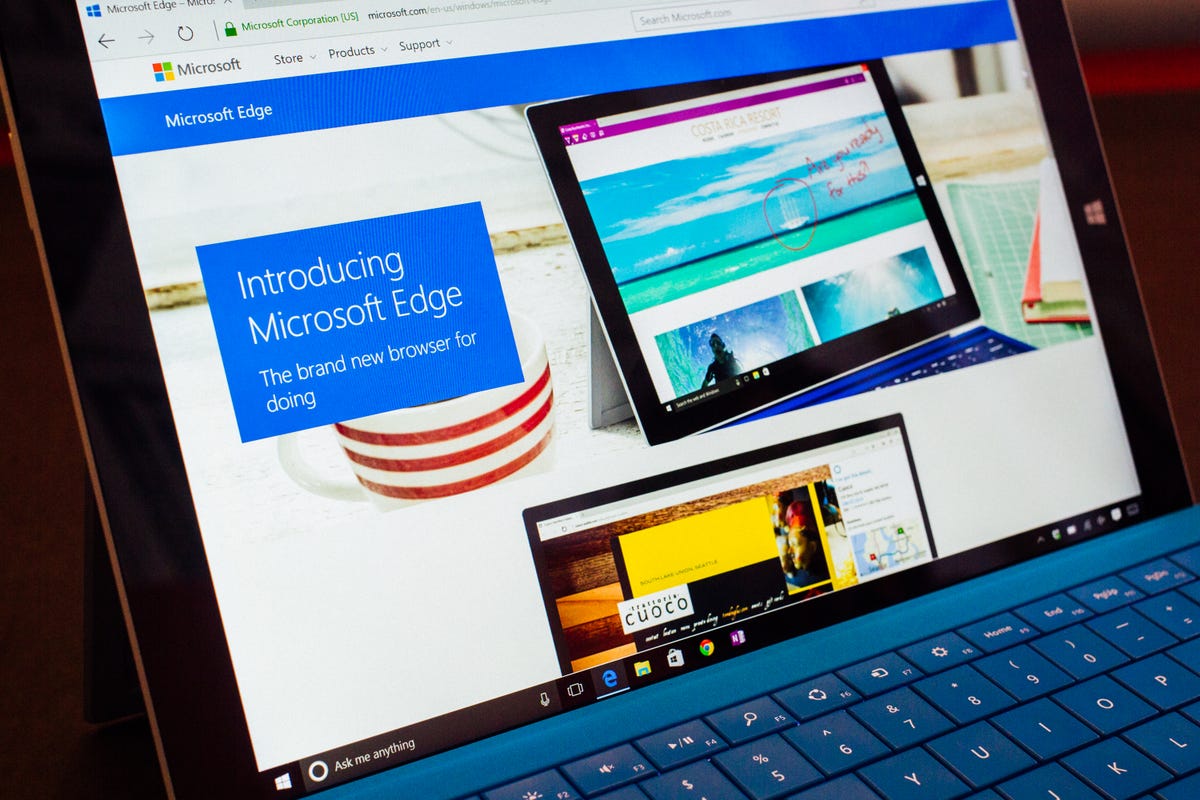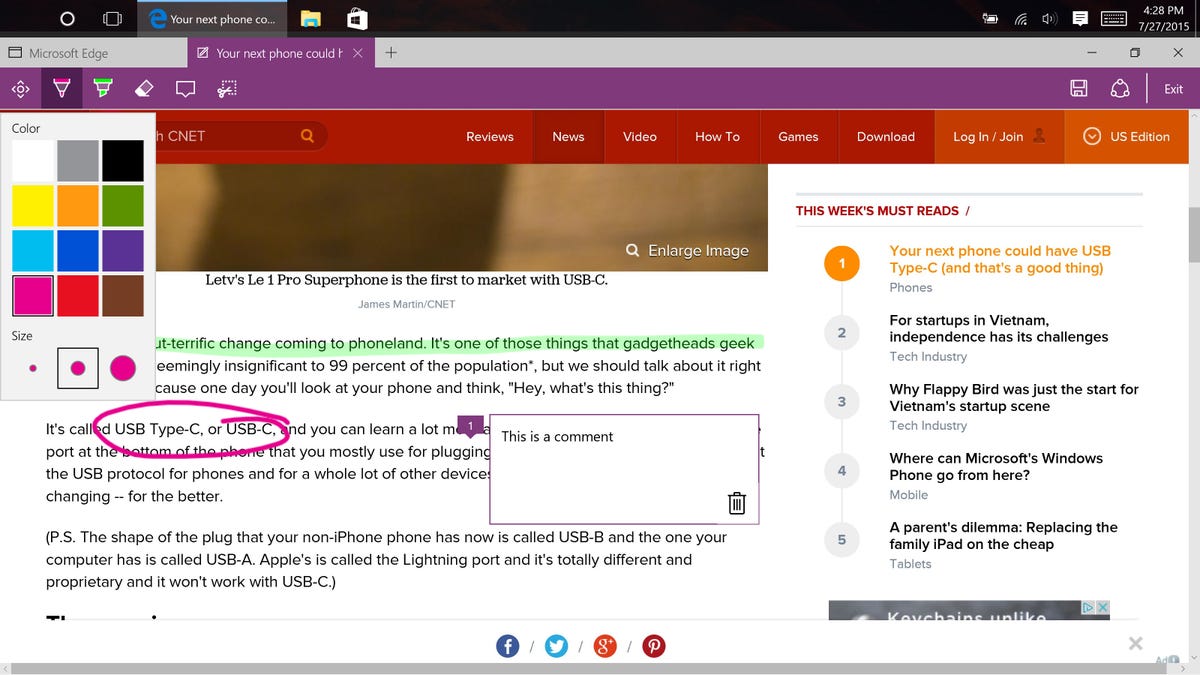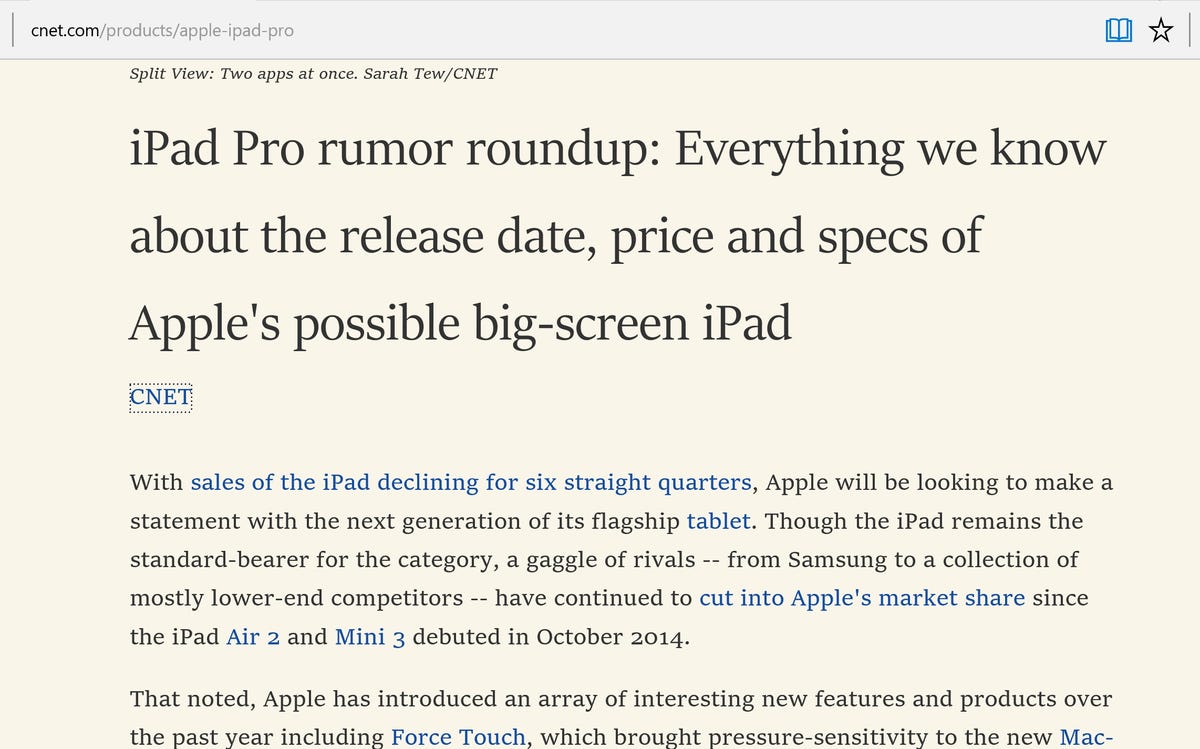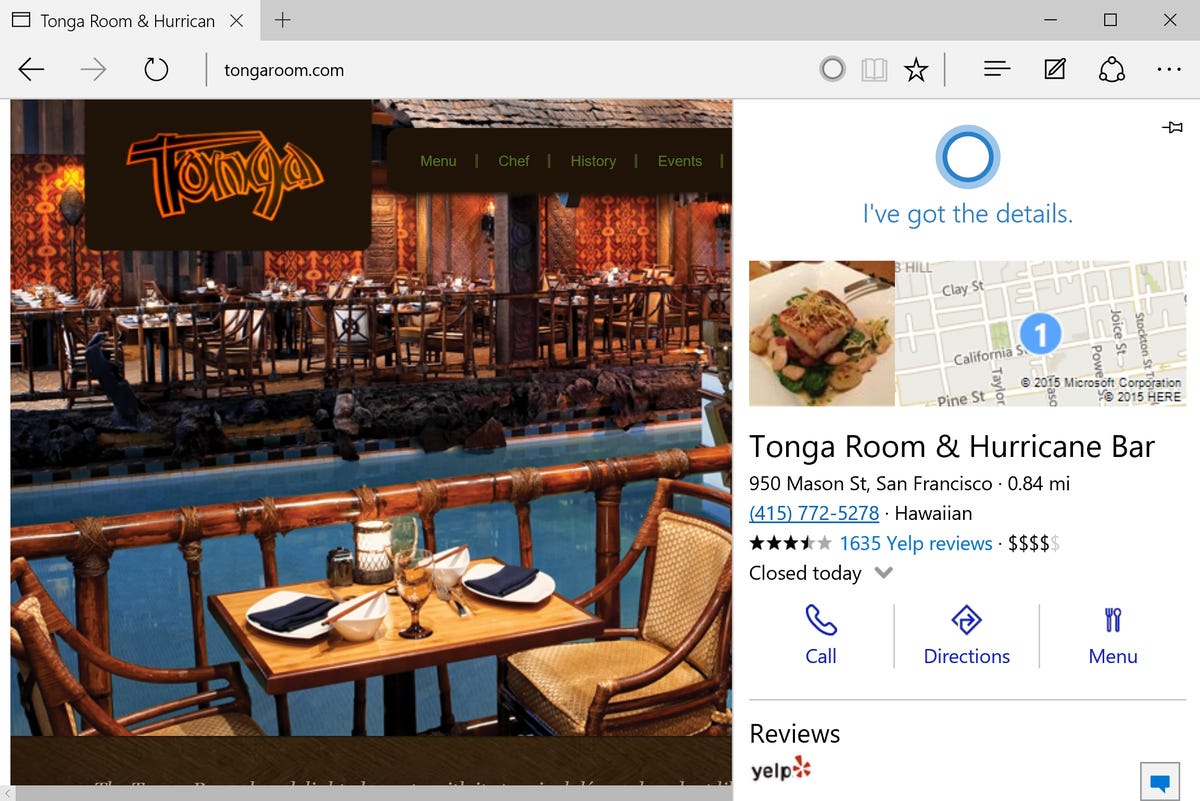
James Martin/CNET
With the launch of Windows 10 comes Edge , Microsoft’s new built-in browser that’s meant to replace Internet Explorer. Though IE will still come with Windows, the older browser is being relegated to “legacy compatibility” duties. Microsoft is urging everyone to use Edge for its faster performance and improved features.
More about Windows 10
- Windows 10: Nine things you need to know
- How to download and install Windows 10
- Windows 10: The CNET review
And don’t panic: you won’t be forced to use Edge. All of your favorite third-party browsers, including Chrome and Firefox, still work fine in Windows 10. And because Edge isn’t a slam-dunk yet, you’ll want to keep those competitors handy.

 Enlarge Image
Enlarge ImageWeb Note on Edge. Click to enlarge.
The edge for Edge
The good news is that you’ll actually want to give it a try. The best thing about Edge is that it’s not “Internet Explorer 12;” it’s a complete reboot, with some nice modern tools and worthy additions, the best of which are highlighted below.
Web Note: A Magic Marker for the Net
Web Note is a mockup tool that lets you capture an image of a website, add notes and sketches, and save it or share it. It’s better than any screenshot tool I’ve ever used because it captures the entire webpage, not just the portion visible on the screen.
Using the pen, highlighter and eraser options, which are controlled with a mouse or your finger on a touchscreen, you can draw and sketch all over the page. There’s also an option to add typed comments and select and clip part of the screen, if you only want to save a small portion of the website. When you’re done sketching and adding comments, you can save the entire mocked-up webpage to OneNote, your Favorites menu in Edge or your Reading list (more on that later). Or, you can share the finished mockup via email.
Web Note is a fantastic for students doing online research, since you can save and highlight text and images. At work, it’s also helpful tool for creating visual aids for projects and presentations. (And yes, the same functionality exists in other browsers via extensions and plug-ins, but it’s nice to have it here by default.)

 Enlarge Image
Enlarge ImageScreenshot by Sarah Mitroff/CNET
Easy reading tools
Edge comes with two tools to make reading online a bit easier. Reading view is a tool that strips out extra parts of a website — like ads and design elements — to give you a clean, focused view with only text, photos and video. It’s a smart tool for when you don’t want distractions, or don’t particularly like a website’s layout. Reading view is very similar to Evernote’s Clearly extension, available for Chrome and Firefox, which also strips out extra parts of a website for reading, though Clearly gives you a few customization options where Edge does not.
What makes Edge special is that this feature is built in, ready to use on most any website. You can tell if a webpage is compatible with Reading view by looking at the book icon in the address bar; if it’s grayed out, Reading view isn’t available, if it’s black, you can use it.
The other tool aimed at anyone who likes reading online is Reading list, a place where you can save an article to read later offline. It’s great for when you find articles throughout your workday that you don’t have time to read until after you leave the office. To use it, just click or tap the star icon in the address bar and select Reading list and follow the prompts.
Apple’s browser Safari has a reading list feature that works very closely to Edge’s, and on Firefox and Chrome you can use a third-party service like Pocket , Readability or Instapaper to save articles for later.

 Enlarge Image
Enlarge ImageScreenshot by Sarah Mitroff/CNET
Cortana finds what you need
Bing and Cortana play a big role in Edge, both giving you extra information at your fingertips. When using the address bar, Bing will show search results as you type for general queries like weather reports, stock performance, math equations and flight statuses. Try typing “weather” and the current conditions in your area will appear. Type an equation and the solution will show up just below the address bar.
If you highlight a word or phrase on a webpage and right click with your mouse, you can Ask Cortana for more information. She’ll show definitions of the word or information from Wikipedia in a menu on the right side, so you don’t have leave the webpage. If Cortana doesn’t find the result you want, you can start a Bing search with a single click to go deeper.
Finally, on websites for select restaurants and bars, Cortana will show maps, directions, reviews, phone numbers and other business information. This isn’t available everywhere, but Cortana will let you know if she has the extra information automatically by telling you in the address bar. Click on Cortana’s circle to see what she found.
What’s lacking versus other browsers
Many of the new features of Edge are also available in some form with Chrome and Firefox, but usually with a third-party extension or add-on you’ll need to enable separately. That’s not a deal breaker for using those browsers, but if you’re looking for simplicity in your browser, Edge might be a great choice.
But despite its advancements, Edge is still behind its competitors when it comes to their most popular features. Chrome and Firefox let you sync bookmarks and open tabs between different computers, so you always have access to the same information everywhere you go. They also support thousands of extensions and add-ons, like 1Password, OneTab and Pinterest, that let you use all sorts of helpful tools right in your browser. Both browsers also let you “pin” a tab, so it takes up less space and stays open. All of these features are currently missing from Edge.
Microsoft has said that it will add support for extensions in fall 2015, which will let you add extra features to Edge and bring it up to speed with Chrome and Firefox. For now, we’re left waiting for Edge to add that and other desired features you can easily get on other browsers.
Should you use it?
If you’ve stuck with Internet Explorer on your Windows machine for all these years and are wondering if Edge is any better, the answer is yes. Microsoft has added significant improvements that make the browser much more useful, especially for casual users. Web Note is particularly useful for researching and saving webpages, while Cortana’s personal assistant search features give you helpful information without digging for it. Edge is more nimble too, as it loads websites quickly and has a modern design that makes menus easy to find.
However, if you’re already loyal to Chrome or Firefox, Edge won’t sway you to leave — at least not in its debut form. Ideally, the promise of those future “power-user” features, like synced tabs and bookmarks and extension support, will make Edge even more compelling soon.




